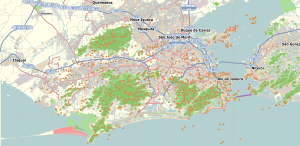Santa Teresa | |
|---|---|
Neighborhood | |
 | |
| Coordinates: 22°55′03″S 43°11′17″W / 22.91750°S 43.18806°W | |
| Country | |
| State | Rio de Janeiro (RJ) |
| Municipality/City | Rio de Janeiro |
| Zone | Centro |
Santa Teresa (Portuguese pronunciation: [ˈsɐ̃tɐ teˈɾezɐ]) is a neighborhood in the city of Rio de Janeiro, Brazil. It is located on top of the Santa Teresa hill, by the centre of Rio, and is famous for its winding, narrow streets which are a favourite spot for artists and tourists.
The neighborhood originated around the Santa Teresa Convent, built in the 1750s on the Desterro hill. At the end of the 19th and early 20th century it was an upper class borough, as testified by its many opulent villas. Santa Teresa ceased being an upper-class neighbourhood long ago, but it has been revived as a fashionable hotspot. It is home to several artists and art studios and galleries. The offer of restaurants and bars is also varied.
One of Santa Teresa's most illustrious inhabitants was Raymundo Ottoni de Castro Maia, an art collector who lived in his Chácara do Céu mansion in the neighborhood. The estate was turned into a museum (Museu da Chácara do Céu) and its exhibits include works by Matisse, Jean Metzinger, Eliseu Visconti, Di Cavalcanti, and Candido Portinari. It is located near the cultural center Parque das Ruínas. In 2006, some paintings were stolen, and have not yet been recovered.[1]
Another museum is the Museu do Bonde, which tells the history of the famous Santa Teresa Tram since its historic origins. A ride on the tram is a popular attraction among tourists. It sports crossing the old Carioca Aqueduct, going through picturesque streets of the Santa Teresa neighbourhood and wonderful views of the city downhill.
